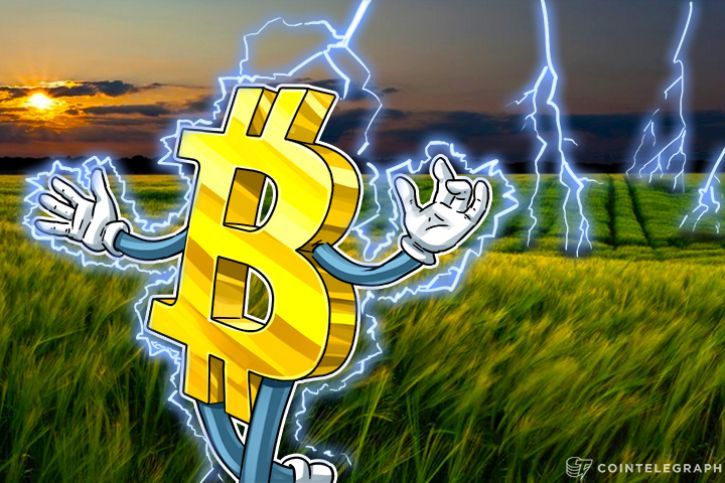At press time, the Bitcoin network is currently facing a backlog of over 135,000 unconfirmed transactions and fees have soared. This comes days after the proponents of the SegWit2x scaling solution announced they wouldn’t move forward with a doubling of Bitcoin’s block size due to lack of consensus. Since larger blocks are clearly dead in the water, there is only one apparent solution to the scalability problem: lightning network.In addition to all the private payment channels they are a part of, each peer would have one channel open to the Bitcoin Blockchain.
The lightning network is scale-free, low-fee solution that has the potential to solve Bitcoin's scalability problem. As transaction volume on the Bitcoin network increases and the amount of data that can fit in a block remains the same, the Bitcoin economy suffers from a congested network. It is beginning to take longer than usual - up to several hours - for a transaction to be confirmed on the Bitcoin network and high transaction fees plague the network once again.
Bitcoin's scalability problem
Bitcoin’s blocks are limited to 1MB in size and the transaction volume on the Bitcoin network is rapidly increasing. The current block size is not sufficient to manage the number of transactions taking place on the Bitcoin network. The scalability problem can be thought of as feeding a large number of inputs through a narrow funnel. As large amounts of Bitcoin transaction data enter into the wide mouth of the funnel, the current amount of block space restricts the amount of transactions that the Bitcoin network can effectively process.
The result is that transactions are written to the Blockchain more slowly than they are created by users. Over time a backlog develops, and transactions may wait hours to be included in a block. Users can ensure their transactions will be confirmed faster, but only for exorbitant fees.
What is the lightning network
The lightning network would implement a smart contract script into the Bitcoin network that would open private payment channels between a peer and all of the other peers they transact with. In addition to all the private payment channels they are a part of, each of peer would have one channel open to the Bitcoin Blockchain.
Peers would transact amongst themselves in their private channels, but only the final outcome of the transaction would be broadcasted to the Blockchain. Because of this, miners would be processing far fewer transactions than they currently do.In theory, the lightning network makes peer to peer transactions more efficient, scale-free, and low cost. The software is being trial-run on the Litecoin network.
Laying a foundation
The road to lightning network’s implementation first ran through the activation of Segregated Witness (SegWit). This code separates signatures from transaction data to free up space in a block. SegWit gave the Bitcoin network the ability to process up to four times as many transactions into a block than before. In practice, however, it’s expected to merely double the capacity of the network.
SegWit was needed to fix Bitcoin’s transaction malleability bug, which would have prevented lightning network from working. Along the way, miners and industry businesses came together in New York to agree to a compromise scaling proposal. The group agreed that SegWit would be allowed to activate as long as it was followed in November by a doubling of the block size to 2MB.
However, on November 8th, SegWit2x was postponed due to lack of support. Since the Bitcoin core developers and the community were so strongly opposed to increasing the block size, the only solution that remains on the table is lightning network.
What makes lightning different?
On the lightning network, verifications would be instantaneous and concurrent with transactions. Private payment channels secured by multi-sig and and time locks allow transactions between peers to occur instantly. This means that individuals would no longer need to wait excessively long amounts of time for their transaction to be confirmed.
Because private channels operate separately from the Bitcoin network, miners will have fewer transactions to process than they currently do. No longer will every single transaction get posted to the Blockchain; rather, only the final results of transactions between peers will be recorded. This leads to a more efficient use of the data limits on the current Bitcoin network.
A scalable and inexpensive protocol like the lightning network has the ability to entice customers away from traditional financial intermediaries like Visa because of cost savings. Merchants will no longer have to pay exorbitant transaction fees, transportation costs, auditing costs and mediation costs. What’s even better is that your transaction will take place directly between you (party one) and the party you are doing business with (party two) without having to pass through a financial intermediary (third party) who has virtually nothing to do with the actual transaction at hand.
Scaling crisis not yet solved
It is becoming clear that the scaling issue is still haunting the Bitcoin network. Over the past few days, the price of Bitcoin has dropped while that of Bitcoin Cash has increased dramatically. Bitcoin Cash is a fork of Bitcoin that removed SegWit and increased the block size to 8MB. Many in the Bitcoin community who supported larger blocks as a scaling solution have likely moved to Bitcoin Cash.
Other altcoins are working on scalability solutions as well; indeed, the ability to scale may well determine the top cryptocurrency a few years from now. If Bitcoin can’t, then others likely will. Already Ethereum is working on scaling by means of its Raiden Network, which uses payment channels similar to lightning network. Likewise, the digital currency Dash is experimenting with using ultra-large blocks to implement true on-chain scaling. The project just released an update that will increase the size of Dash’s blocks to 2MB when it fully activates, in about a month.


